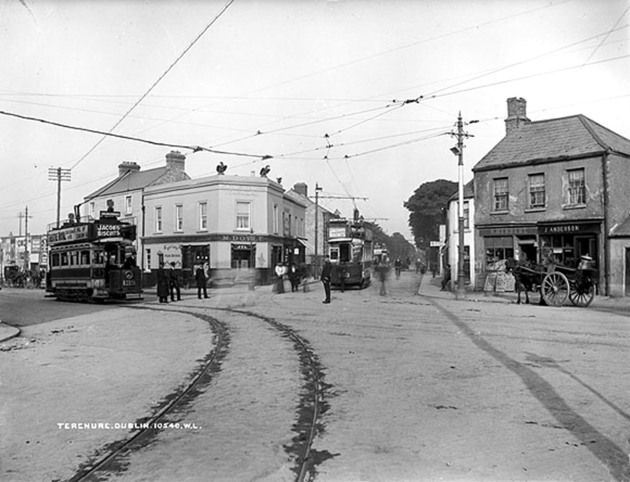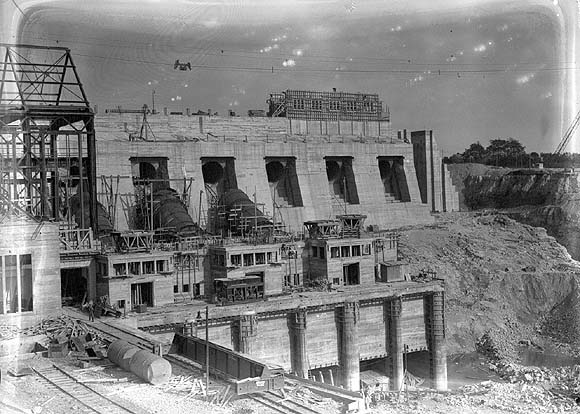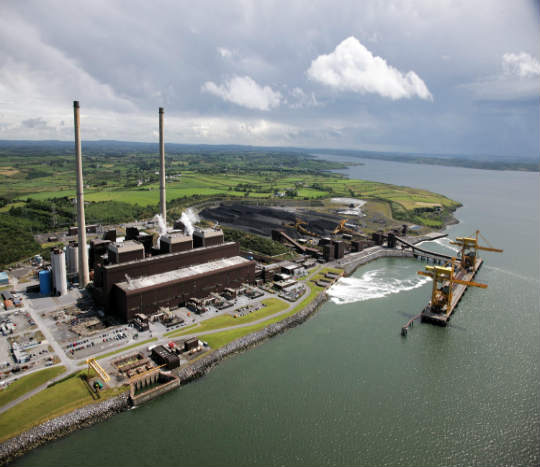Modern energy supply began as a private or local service of gas and electricity, largely based on coal in the early 20th Century. This grew to become national state-owned utilities, which was later unbundled to facilitate competition in generation and customer choice of supplier. The pattern of energy demand has shifted over the years reflecting economic growth throughout history as well as changing relative costs of different fuels, the perceived security of continued supplies and more recently, environmental considerations.
1880
- 1880 The first public electric light in Ireland was established at Prince’s Street in Dublin outside the offices of the Freeman’s Journal.

1890
- 1892 Dublin Corporation opened its first electricity Power Station in Fleet Street.
- 1896 An electric tram was operated by the Dublin Southern District Tramways Company from Haddington Road to Dalkey.
1900
- 1901 With the growing interest in electricity a private act of Parliament was passed in 1901 authorising the development of bogs in Leinster for electric power.
1910
- 1911 Peat is used to generate electricity in industry e.g. Hamilton Robbs linen factory or the Marconi wireless station.
1920
- 1922 130 public electric supply schemes exist in Ireland, alongside a number of private undertakings.
- 1925 The Shannon Electricity Bill was passed after acromonious debate to provide State electricity by means of hydraulic power derived from the waters of the Shannon.
- 1925 By this time hydro, coal, peat, gas and wind power were all being utilised in one form or another to generate electricity.
- 1927 The ESB (Electricity Supply Board) is established to provide a safe, reliable and economic supply of electricity to the community under the Electricity Supply Bill.
- 1929 Ireland’s first large-scale electricity hydropower station commissioned at Ardnacrusha, Co. Clare.
- 1929 The coal-fired station at Pigeon House is acquired by ESB.

1930
- 1933 The commissioning of another turbine marked the final development at the Ardnacrusha hydropower station.
- 1938 Double deck buses using internal combustion engines replaced electric powered trams in Dublin.

1940
- 1946 ESB’s Rural Electrification Scheme aims to deliver electricity to half a million homes facilitated by the post war upsurge in generation and transmission projects.
1950
- 1950 World prices of oil had fallen after the war to a point where it became competitive with coal for gas manufacture and power generation.
- 1950 High coal prices meant that those gas companies which had survived the hardships of the war moved away from coal carbonisation.
- 1950 First peat-fired generation station in Portarlington opens. Between 1950 and late 1960s, ESB installs over 400 MW of peat power plants.
- 1956 Electricity rationing may have been avoided after the Suez crisis in part due to peat fired power stations and their ability to operate with less expensive fuels than oil.
- 1956 As more peat fired stations came on stream supporting infrastructure was developed such as the first railway bridge to be built across the Shannon for 100 years.
1960
- 1960 Seven exceptional years of low peat yields during a decade of stable economic growth during which demand for electricity grew steadily.
- 1968 Construction of Ireland’s only pumped hydroelectric storage station in Turlough Hill begins.
1970
- 1971 ESB completes large oil fired power station at Poolbeg in Dublin.
- 1976 Kinsale gas is landed five years after discovery. The major users of the gas initially was a new fertiliser works at Marino Point and, some years later, the power station at Aghada, both located on Cork Harbour.
- 1977 The ESB and the Government propose to build a nuclear power station at Carnsore Point, Co. Wexford.
- 1979 Construction of a coal-fired power station at Moneypoint Co Clare began and plans for a nuclear power station at Carnsore Point, Co. Wexford are shelved.

1980
- 1980 Financial crisis, temporary high oil prices creating an artificial market, price controls, the ageing of ESB peat fired power stations and the introduction of the private bog scheme.
- 1981 The dominant fuel for space heating was electricity.
- 1981 Several demonstration wind turbines installed by the Department of Energy in 13 projects around the country
- 1987 Ireland’s single remaining coal fired power plant opens at Moneypoint as part of a fuel diversity strategy. At full output the station consumes approximately 7000 tonnes of coal per day.
1990
- 1992 The first wind farm comprising of 21 wind turbines in Bellacorrick, County Mayo comes online with an installed capacity of 6.45 MW, supported by the EU VALOREN programme.
- 1993 Bord Gáis build the first Irish sub-sea gas interconnector pipeline from Moffat in Southwest Scotland to Loughshinny in North County Dublin.

2000
- 2002 Sustainable Energy Authority of Ireland (SEAI) established as a statutory authority under the Sustainable Energy Act. Delivers a range of energy efficiency, renewable energy and CHP programmes.
- 2004 Electricity generated from wind exceeded that from hydro for the first time.
- 2004 Tram services returned to Dublin with the opening of the Luas.
- 2005 EU Emissions Trading Scheme established covering emissions from major power and heat generation facilities.
- 2007 Installed wind capacity of 795 MW.
- 2007 All island Single Electricity Market established.
- 2007 Renewable Heat Deployment Programme and Combined Heat and Power Deployment Programme launched.
- 2009 Renewable Energy Directive individually binding targets – 16% of energy from renewable sources by 2020 for Ireland. National targets of 40% renewable electricity, 10% renewable transport, and 12% renewable heat by 2020.

2010
- 2011 One municipal waste to energy plant in Ireland in County Meath. Renewable share of waste produces renewable electricity.
- 2012 High gas prices and low coal and ETS prices resulted in more coal and peat being used for electricity generation.
- 2012 20% of Ireland’s electricity is produced from renewables, mainly wind.
- 2013 Solar energy provided 1.2% of the renewable primary energy (all of this was in the residential sector).
- 2014 Ireland achieves 6.6% of heat from renewable sources (12% target for 2020), 3.1% renewable transport or 5.2% if using double certificate weightings (10% target), and 22.7% renewable electricity (40% target).
- 2015 562 electric vehicles sold in 2015. Government target of 50,000 electric vehicles on the road by 2020.